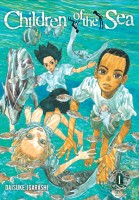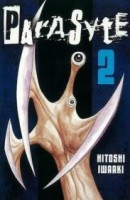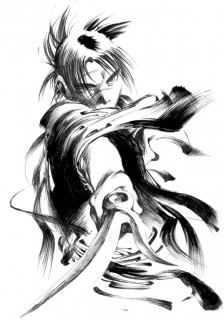Despite having written at Experiments in Manga for over three years, I have never once attempted to create a “best of the year” list and I’m not about to start. However, I thought it would be interesting to write a post reflecting on what I have read in the past year. This isn’t a best of list. It’s not even necessarily a list of my favorite releases of the year (although, some of them certainly are). Instead, it’s a collection of manga, comics, and fiction from 2013 that, for one reason or another, were particularly notable for me.
 I’ll start out with Moto Hagio’s The Heart of Thomas. Fantagraphics released the entire series in a beautiful, hardcover omnibus. Technically, I think it was published at the end of 2012, but I wasn’t able to get my hands on one until 2013. I adore Hagio’s manga and wish more of it was available in English. The Heart of Thomas in particular is a historically significant work and one of the precursors to the boys’ love genre. Plus, it’s a wonderful work in its own right.
I’ll start out with Moto Hagio’s The Heart of Thomas. Fantagraphics released the entire series in a beautiful, hardcover omnibus. Technically, I think it was published at the end of 2012, but I wasn’t able to get my hands on one until 2013. I adore Hagio’s manga and wish more of it was available in English. The Heart of Thomas in particular is a historically significant work and one of the precursors to the boys’ love genre. Plus, it’s a wonderful work in its own right.
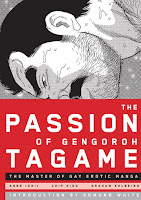 The Passion of Gengoroh Tagame: The Master of Gay Erotic Manga probably couldn’t be more different from The Heart of Thomas, but I anticipated its release just as much. Tagame is an incredibly influential gay comics artist. The volume was not only the first collection of his work to be released in English, it was also the first collection of bara manga to be released in print. Happily, it won’t be the last. More of Tagame’s manga is already scheduled to be published.
The Passion of Gengoroh Tagame: The Master of Gay Erotic Manga probably couldn’t be more different from The Heart of Thomas, but I anticipated its release just as much. Tagame is an incredibly influential gay comics artist. The volume was not only the first collection of his work to be released in English, it was also the first collection of bara manga to be released in print. Happily, it won’t be the last. More of Tagame’s manga is already scheduled to be published.
 I have become increasingly interested in yokai over the last few years. And so I was thrilled when Drawn & Quarterly released Kitaro by Shigeru Mizuki. The volume collects stories from the first few volumes of Mizuki’s GeGeGe no Kitaro which is the yokai manga that started it all and which continues to influence creators to this day. I found Kitaro to be utterly delightful and can understand why it’s so well-loved. I hope more of the series will be translated.
I have become increasingly interested in yokai over the last few years. And so I was thrilled when Drawn & Quarterly released Kitaro by Shigeru Mizuki. The volume collects stories from the first few volumes of Mizuki’s GeGeGe no Kitaro which is the yokai manga that started it all and which continues to influence creators to this day. I found Kitaro to be utterly delightful and can understand why it’s so well-loved. I hope more of the series will be translated.
 I picked up Mobile Suit Gundam: The Origin for one reason—it was written and drawn by Yoshikazu Yasuhiko. I’m not at all a Gundam fan, but I am a fan of Yasuhiko’s work. Even so, I didn’t anticipate how much I would enjoy The Origin. The manga ended up being an extremely well done space opera. It doesn’t hurt that Vertical’s edition of the series is one of the highest quality manga releases available in English, either. I’m still not a Gundam fan, but I am a fan of The Origin.
I picked up Mobile Suit Gundam: The Origin for one reason—it was written and drawn by Yoshikazu Yasuhiko. I’m not at all a Gundam fan, but I am a fan of Yasuhiko’s work. Even so, I didn’t anticipate how much I would enjoy The Origin. The manga ended up being an extremely well done space opera. It doesn’t hurt that Vertical’s edition of the series is one of the highest quality manga releases available in English, either. I’m still not a Gundam fan, but I am a fan of The Origin.
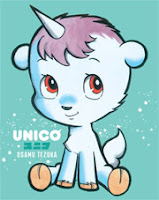 Another manga that I was pleasantly surprised by was Osamu Tezuka’s Unico. As much as I appreciate Tezuka’s work, I will admit to have grown a little tired of it. (I wish that other classic manga received the same amount of attention in English.) I approached Unico more as a curiosity than anything else; the full-color artwork and unusual page layouts had caught my attention. It turned out to be an endearing manga that is both heartbreaking and charming.
Another manga that I was pleasantly surprised by was Osamu Tezuka’s Unico. As much as I appreciate Tezuka’s work, I will admit to have grown a little tired of it. (I wish that other classic manga received the same amount of attention in English.) I approached Unico more as a curiosity than anything else; the full-color artwork and unusual page layouts had caught my attention. It turned out to be an endearing manga that is both heartbreaking and charming.
 After years of delay, Suehiro Maruo’s The Strange Tale of Panorama Island was finally released by Last Gasp in 2013. The manga is an adaptation of Edogawa Rampo’s novella Strange Tale of Panorama Island which, coincidentally, was also released in English in 2013. I cannot think of a more perfect artist to adapt Rampo’s work; Maruo’s exquisite, sensual, and erotically charged illustrations with hints of the macabre are an ideal fit. The Strange Tale of Panorama Island was worth the wait.
After years of delay, Suehiro Maruo’s The Strange Tale of Panorama Island was finally released by Last Gasp in 2013. The manga is an adaptation of Edogawa Rampo’s novella Strange Tale of Panorama Island which, coincidentally, was also released in English in 2013. I cannot think of a more perfect artist to adapt Rampo’s work; Maruo’s exquisite, sensual, and erotically charged illustrations with hints of the macabre are an ideal fit. The Strange Tale of Panorama Island was worth the wait.
 As for continuing series in 2013, Takako Shimura’s Wandering Son remains a manga that is incredibly important to me on a very personal level. I’m pretty sure that I’ve mentioned it before, but Wandering Son has quite literally been life-changing for me. In addition to that, I simply think it’s a wonderfully sensitive and sincere look at personal identity. Fantagraphics released both the fourth and fifth volumes of Wandering Son in 2013; I’m looking forward to reading more of the series great deal.
As for continuing series in 2013, Takako Shimura’s Wandering Son remains a manga that is incredibly important to me on a very personal level. I’m pretty sure that I’ve mentioned it before, but Wandering Son has quite literally been life-changing for me. In addition to that, I simply think it’s a wonderfully sensitive and sincere look at personal identity. Fantagraphics released both the fourth and fifth volumes of Wandering Son in 2013; I’m looking forward to reading more of the series great deal.
 2013 also saw the release of Ai Yazawa’s Paradise Kiss, Part 3—the third and final volume in Vertical’s edition of the series. I missed out on the manga when it was originally licensed by Tokyopop and I’m very glad to have had the opportunity to read it. Over the last year, I have been extremely impressed by Yazawa’s work. I don’t have a particular interest in fashion, but the complex characters and complicated relationships in Paradise Kiss were extraordinary.
2013 also saw the release of Ai Yazawa’s Paradise Kiss, Part 3—the third and final volume in Vertical’s edition of the series. I missed out on the manga when it was originally licensed by Tokyopop and I’m very glad to have had the opportunity to read it. Over the last year, I have been extremely impressed by Yazawa’s work. I don’t have a particular interest in fashion, but the complex characters and complicated relationships in Paradise Kiss were extraordinary.
 The One Trick Rip-Off + Deep Cuts is a fantastic anthology which collects fifteen comics by Paul Pope, including those he created for Kodansha while in Japan. The volume makes a great introduction to Pope’s comics, exhibiting a nice range of styles and stories selected from nearly a decade of his work. The influence of manga can be seen in the collection, but Pope definitely has his own approach to comics. I’ve become very fond of his work and the quirkiness of his stories and characters.
The One Trick Rip-Off + Deep Cuts is a fantastic anthology which collects fifteen comics by Paul Pope, including those he created for Kodansha while in Japan. The volume makes a great introduction to Pope’s comics, exhibiting a nice range of styles and stories selected from nearly a decade of his work. The influence of manga can be seen in the collection, but Pope definitely has his own approach to comics. I’ve become very fond of his work and the quirkiness of his stories and characters.
 Written and illustrated by Gene Luen Yang with colors by Lark Pien, the Boxers & Saints duology is honestly one of the best comics that I read in the past year. It’s a powerful retelling of the Boxer Rebellion—a violent uprising in China that began in the late 1800s—from two different sides of the conflict, neither of which were entirely in the right. Yang put a tremendous amount of research into the work, making it historically accurate while still maintaining a very human element to the story.
Written and illustrated by Gene Luen Yang with colors by Lark Pien, the Boxers & Saints duology is honestly one of the best comics that I read in the past year. It’s a powerful retelling of the Boxer Rebellion—a violent uprising in China that began in the late 1800s—from two different sides of the conflict, neither of which were entirely in the right. Yang put a tremendous amount of research into the work, making it historically accurate while still maintaining a very human element to the story.
 I already knew that I enjoyed Toh EnJoe’s short stories and essays and so I was excited for the release of Self-Reference Engine, the first book-length work of his to be translated into English. It’s not quite a novel, and it’s not quite a collection of short stories, but whatever it is it’s good stuff. I expected Self-Reference Engine to be intellectually stimulating as well as entertaining, and it was, but I wasn’t prepared for how funny and mind-bending it would be.
I already knew that I enjoyed Toh EnJoe’s short stories and essays and so I was excited for the release of Self-Reference Engine, the first book-length work of his to be translated into English. It’s not quite a novel, and it’s not quite a collection of short stories, but whatever it is it’s good stuff. I expected Self-Reference Engine to be intellectually stimulating as well as entertaining, and it was, but I wasn’t prepared for how funny and mind-bending it would be.

